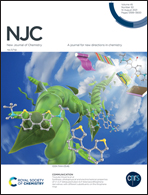Unveiling the regioselectivity in electrophilic aromatic substitution reactions of deactivated benzenes through molecular electron density theory†
Abstract
The origin of the meta regioselectivity in electrophilic aromatic substitution (EAS) reactions of deactivated benzene derivatives is herein analysed through Molecular Electron Density Theory (MEDT). To this end, the EAS reaction of benzenesulfonic acid with the nitronium NO2+ ion in H2SO4 solution has been studied at the ωB97X-D/6-311G(d,p) level. This reaction takes place through a two-step polar mechanism involving the formation of an unstable cation intermediate. The activation Gibbs free energies associated with the three competitive regioisomeric reaction paths are found in the narrow range of 15.5–18.3 kcal mol−1. By using the Eyring–Polanyi equation a relationship of 18.7 (ortho) : 81.0 (meta) : 0.3 (para) is obtained, in agreement with the experimental outcome. From this MEDT study it is possible to conclude that the presence of the SO3H group in benzenesulfonic acid only slightly polarises the aromatic electron density towards the substituted C1 position. However, while the SO3H group markedly deaccelerated the EAS reaction with respect to that of benzene, its presence has a low impact in the regioselectivity, which is the result of the slight polarization of the ring electron density towards the substituted C1 carbon and the weak repulsive steric interactions appearing along the ortho approach mode, and not due to the stability of resonance structures as was proposed.



 Please wait while we load your content...
Please wait while we load your content...